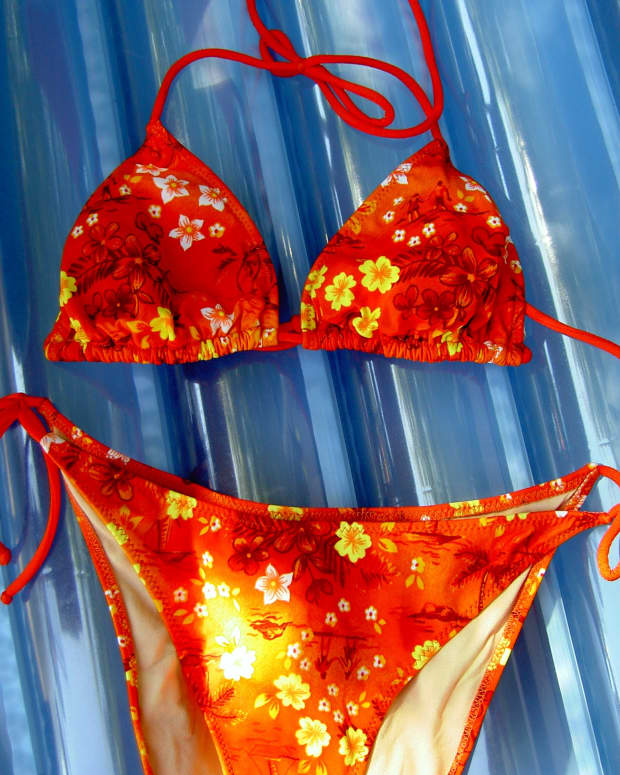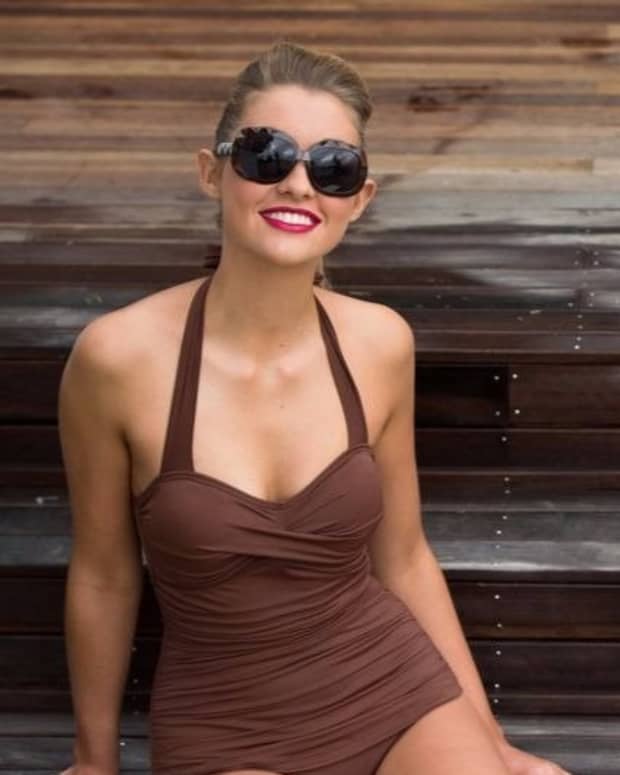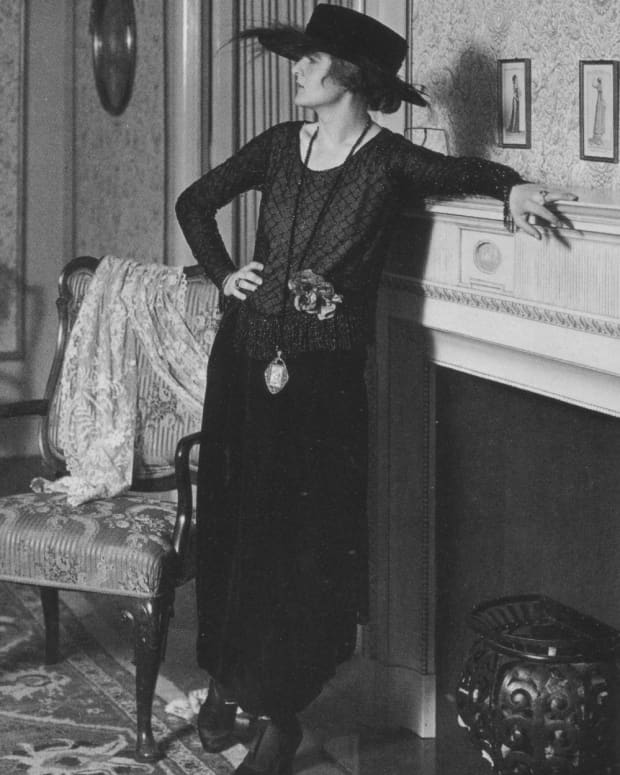Swimsuits: The History of Swimwear for Women
Dolores's interest in fashion history dates from her teenage years when vintage apparel was widely available in thrift stores.
Although the practice of swimming has been around for a very long time, the concept of a swimsuit as fashion is relatively new. Early bathing costumes had more to do with modesty than with looks or function. And although Victorian women wore bathing costumes at the beach, a woman could certainly not swim in one comfortably.
The swimsuit as a fashionable garment that provides enough freedom of movement be worn in the water is a 20th-century concept.
Of course, today's bikini is not the most convenient garment to wear in the surf. And you'd have to think twice about jumping into a chlorinated pool while wearing a couture swimsuit that cost hundreds of dollars, but swimsuits have come a long way from early 20th-century wool sacks.

Bikini Girls Circa 4 AD. Anyone for Beach Volleyball?
Wikimedia commons; Photo by Rondtheworld Released into Public Domain
Ancient Swimmers
Ten-thousand-year-old Neolithic pictographs depict humans in poses as if they are swimming. Ancient Babylonian and Assyrian wall art suggests swimming, as does a 4,000 - 9,000-year-old Egyptian clay tablet.
Written references to swimming in ancient times occur in Gilgamesh, the Iliad, and the Odyssey. The Bible mentions swimming several times, including Isaiah 25:11: "And he shall spread forth his hands in the midst of them as he that swimmeth spread forth his hands to swim..."
The apparently bikini-clad girls in the Ancient Roman mosaic from the Villa Romana del Casale, Sicily (as shown above ) participate in an athletic event that looks a lot like beach volleyball.
Ancient Rome offered public bathhouses for hygienic purposes, but the practice died out after the fall of Rome.
Swimming in the Middle Ages
At a time when the Church set stringent dress codes that demanded modesty, and Europeans shied away from water as well as hygiene, swimming as a popular sport fell by the wayside. However, swimming was one of the seven skills of knights during the Middle Ages.
In 1539, Nicolas Wynman, a German professor, wrote the first European book (Colymbetes) on swimming.
In 1587, Everard Digby of St. James College, Cambridge, wrote a piece on the art of swimming featuring illustrations of swim strokes, including the breaststroke, backstroke, and crawl.
By the late 1600s, health enthusiasts came to believe that immersion into mineral baths and natural springs was therapeutic. Public baths became popular in towns like Bath, England, where women took the waters wearing stiff canvas smocks with huge sleeves. The bathing costumes were usually yellow, as the water tinted any fabric that color.
Seaside Resorts and Bathing Machines
As the concept that water was healthy gained popularity, saltwater bathing began to attract people to seaside towns. Men and women had segregated beaches for modesty.
For women, healthy sea immersion generally meant a quick dip in the water, including cold water dips in the winter months. In order to preserve a woman's modesty, bathing machines were developed to shield the women from the view of people on the beach.
Women entered small huts made of wood or canvas and changed into bathing dresses - smocks made of stiff fabric so as not to cling to the figure. Lead weights sewn into the hems prevented the bathing costumes from floating up to the surface of the water. Actual swimming or floating would be difficult if not impossible when wearing such heavy garments. Bathing costumes could be rented or purchased ready-made.
The bathing machine was then hauled out into the sea by a horse and driver. Bathers entered the water, shielded from view by the machine as well as an awning. Professional dippers, employed to assist the ladies, gently (or firmly) dunked the women under the water up to 3 times. As the practice became more commonplace and thought of as a pleasurable act, dippers soon fell by the wayside.
Women of the day also wore beach attire - dresses with hemlines a bit shorter than fashionable.
Read More From Bellatory
The bathing machine is thought to have originated in the mid-1700s, although one is pictured in a 1736 engraving of a Scarborough beach scene by John Setterington.
Victorian Bathing Suits
By the early 19th century, bathing became recreational as well as healthy and seaside holidays gained popularity. The great writer Jane Austen so enjoyed her dips that she occasionally overdid it, exhausting herself.
By the mid -1800s, mixed bathing became more acceptable and stationary beach huts replaced bathing machines in some areas. Bathing costumes became more publicly visible and appeared in ladies' fashion magazines. New styles followed fashion trends and often changed from year to year.
During the Victorian period, modesty was still a priority and women wore short dresses and ankle-length pantaloons. Bathing costume fabric made of wool flannel or serge remained stiff so as not to reveal the female form. Dark colors prevailed, being less revealing than light colors.
Fashion-conscious women wore bathing costumes with wide sailor collars and decorative edging or braid in contrasting colors. Full-length dark stockings were worn in the water along with flat-soled bathing shoes that tied on with ribbons. Capes provided additional coverage for the walk from the water to changing rooms.
In 1847, Nancy Edberg was the first female swimming instructor in Europe, giving lessons in Sweden, Denmark, and Norway. She offered public swimming exhibitions and began to create a new interest in the sport for women.
By the late 19th century, the term "bathing suit" was common. Ease of movement in the water entered into designs that offered shorter pantaloons, shorter skirts, and short sleeves. While the skirted bathing costumes persisted into the next century, more revealing costumes were also worn.
Before gender-based desegregation of beaches, men generally swam nude. As mixed bathing increased, men wore garments designed for the water. One-piece knit suits with short sleeves and knee-length pants were popular. In the late 1800s, two-piece versions consisted of short-sleeved or sleeveless tunics over knee-length pants. Dark colors with contrasting bands were the norm, but striped bathing costumes were popular in France.
Indecent Exposure
In 1901 the United Kingdom ended enforced gender segregation on public beaches.
In 1907 the great Australian swimmer, Annette Kellerman, was arrested on a Boston beach for indecent exposure. A competitive swimmer and proponent of the new sport, synchronized swimming, Kellerman wore a swimsuit that exposed her arms, legs, and neck. In a time when women took a new interest in vigorous physical activity, Kellerman's attempt to free them from heavy, restrictive garments set the tone for the new century.
Kellerman, known as the Underwater Ballerina, changed her swim attire to adhere to modesty dress codes by lengthening the legs and sleeves, and raising the collar of her suit design. She added long stockings as well. But the stage was set.
Though the loose, floppy bathing costumes persisted for some until the 1920s swimsuit designers began to create suits that were more practical and comfortable. The suits of competitive and serious female swimmers lost the skirts in the early part of the century. Carl Jantzen designed the first functional two-piece swimsuit in 1913.
In the 1920s women wore close-fitting one-piece suits that resembled men's suits. A small apron at the bottom of the suit remained for modesty. Lastex, a new miracle fiber introduced in 1925 offered two-way stretch. The fiber consisted of cotton, silk, or rayon thread wrapped around an elastic core.
By the 1930s women's swimsuits began to resemble modern swimming attire. Many swimsuits of the 1930s would not look out of place today.
In the 1940s corset manufacturers created bathing suits with built-in tummy control panels. Bra cups accentuated the female figure. Bathing suits became glamorous and were featured in popular film extravaganzas called aquamusicals. Large groups of women performed synchronized swimming and diving routines against beautiful backdrops of lights and fountains. Esther Williams starred in many of these films as well as in a biographical film called, Million Dollar Mermaid based on the life of Annette Kellerman
In 1946 Louis Reard introduced the first bikini, named after Bikini Atoll where the US tested the atomic bomb. Imagining that the revealing new suits would be as dramatic and controversial as the atomic bomb, Reard hired a stripper to model the first suit. Though it took some time for the bikini to catch on, things were never the same again.
While women's suits retained their modesty aprons well into the late 20th century, swimsuits became more revealing. Even one piece maillots show skin with plunging necklines and high cut leg openings.
Today, many styles are available, including longline unitard type suits for competitive swimming, one-piece swimsuits that feature small skirts, two pieces with skirts, wrap style swimsuits, and, of course, the bikini.
A modest type swimsuit called the burkini covers the entire body (except extremities) featuring a long-sleeved tunic and leggings.
Annette Kellerman's Water Ballet
1925 Bathing Beauties
For Further Reading
"Twentieth Century Fashion," Encyclopedia of Clothing and Fashion; edited by Valerie Steele Vol. 3
Splash 10,000 Years of Swimming by Howard Means
Splash! A History of Swimwear by Richard Martin
The Swimsuit: A History of Twentieth Century Fashion by Sarah Kennedy
Questions & Answers
Question: Is it acceptable for men to wear female swimwear?
Answer: Of course these days anyone can wear anything that they like. Whether it's acceptable or not depends on where you wear it. There are some places that are more conservative than others. A man wearing a woman's swim suit may earn some curious looks. And of course there are people out there who may react in a very nasty manner. Remember that there are men out there who think that it's okay to assault women who are wearing something deemed inappropriate.
But the big problem with a man wearing a woman's swim suit is the fit. Swim wear is designed to fit the form of the wearer. A man may find that the upper part of the suit is baggy while the bottom of the suit is too tight at the front and too saggy at the rear.




























